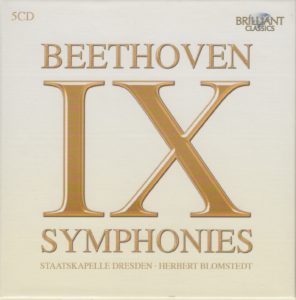 A couple of years ago (April 15, 2014 – July 9, 2014, to be exact), I listened to everything Beethoven composed as part of a (failed) three-year exploration of great works that I called 1095 Days With The Masters And Me. (You can read about why my three-year project failed on the My Year-Long Project page.)
A couple of years ago (April 15, 2014 – July 9, 2014, to be exact), I listened to everything Beethoven composed as part of a (failed) three-year exploration of great works that I called 1095 Days With The Masters And Me. (You can read about why my three-year project failed on the My Year-Long Project page.)
Then, the box set was the Beethoven Complete Edition, the conductor for the symphonies was Herbert Blomstedt (1927- ), and the label was Brilliant Classics, what I consider to be one of the best Classical music labels in the world.
As of this morning (July 24, 2018), that particular 86-CD box set appears to be out of print. So the price I paid for it ($104.75) New on April 9, 2014, has quadrupled to $452.32 New today.
Fortunately, another updated edition (85 CDs) was released in 2017 and you can find it here for just under $140. It’s a steal, believe me.
 I mention that box set because today’s Beethoven music was taken from that 86-CD box set, as a neat, tidy, value-priced 5-CD set conducted by Herbert Blomstedt. It is still available on Amazon for the ridiculously low price of $14.99 – less than $3 per disc. As you will discover reading today’s blog post, this could be the greatest value in Classical music you’re likely find anywhere.
I mention that box set because today’s Beethoven music was taken from that 86-CD box set, as a neat, tidy, value-priced 5-CD set conducted by Herbert Blomstedt. It is still available on Amazon for the ridiculously low price of $14.99 – less than $3 per disc. As you will discover reading today’s blog post, this could be the greatest value in Classical music you’re likely find anywhere.
Here’s Symphony No. 1 in C Major, from the liner notes of the Brilliant Classics Beethoven Complete Edition:
SYMPHONY NO.1 IN C MAJOR OP.21
Beethoven began sketching what was to become his Symphony No.1 in C major, Op.21, in 1795 but although he made extensive sketches of its first three movements, he was unable to find a satisfactory way to conclude it. However some time in 1799, he decided that a simple ascending scale motif, which he had sketched for use in the opening movement, was the ideal starting point for the finale and, although he had to revise the previous movements in the light of this change, he now managed to complete the work quickly. The ascending scale can in fact be heard very softly in the strings at the beginning of symphony, then at the transition from the introduction to the Allegro con brio section and once again at the beginning of the third movement. The second movement Andante is really a minuet in disguise and the third movement, although called a Minuet, is really a scherzo, whose tempo marking Allegro molto e vivace, gives the game away immediately.The finale, in which the ascending scale now takes on a prominent role, begins with a joke and one 19th century conductor, fearing that the audience might laugh at it, chose to omit the opening bars. After a dramatic chord, as if in preface to some grand statement, the music picks its way with comic hesitancy up the scale, finally making it to the top on the sixth attempt. Once launched, the movement continues with Haydnesque good humour…
I just love “jokes” in Classical music. The average listener – of which I am one – would never know about the highjinks going on behind the scenes if not for liner notes.
I have no idea who wrote these particular liner notes because nowhere in their 119 pages do the liner notes tell me. Nor, do the liner notes inform me when this symphony was recorded, although the back of the CD sleeve indicates dates of 1976 and 1979. But I can’t tell if that means Symphony No. 1 comes from 1976 and Symphony No. 3 (which shares the CD and, thus, the back of the sleeve) comes from 1979. I will assume that, although I wish Brilliant Classics had made it more clear – or put that information in their otherwise extensive liner notes.
Information about Herbert Blomstedt from his entry on Wikipedia:
Herbert Blomstedt (born July 11, 1927) is a conductor laureate of the San Francisco Symphony. [He] was born in Springfield, Massachusetts, and two years after his birth, his Swedish parents moved the family back to their country of origin. He studied at the Stockholm Royal College of Music and the University of Uppsala, followed by studies of contemporary music at Darmstadt in 1949, Baroque music with Paul Sacher at the Schola Cantorum Basiliensis, and further conducting studies with Igor Markevitch, Jean Morel at the Juilliard School, and Leonard Bernstein at Tanglewood’s Berkshire Music Center. Blomstedt also lived in Finland during his youth.
He won the Koussevitzky Conducting Prize in 1953 and the Salzburg Conducting Competition in 1955.
Blomstedt is most noted for his performances of German and Austrian composers, such as Beethoven, Felix Mendelssohn, Johannes Brahms, Franz Schubert, Anton Bruckner, Richard Strauss and Paul Hindemith, and also as a champion of Scandinavian composers, such as Edvard Grieg, Franz Berwald, Jean Sibelius and Carl Nielsen.
A devout Seventh-day Adventist, Blomstedt does not rehearse on Friday nights or Saturdays, the Sabbath in Seventh-day Adventism. He does, however, conduct concerts, since he considers actual performances to be an expression of his religious devotion rather than work.
Maestro Blomstedt is 91 years old, and he is still conducting. When he turned 90, the New York Times wrote this article about him. What a fascinating man.
Beethoven wrote his symphonies in four parts (except for the Sixth, which is in five). The time breakdown of this one (Symphony No. 1 in C Major), from this particular conductor (Blomstedt, at age 49) and this particular orchestra (Staatskapelle Dresden), at this particular time in history (1976) on this particular record label (Brilliant Classics) is as follows:
I. Adagio molto………………………………………………………………………………..9:03
II. Andante cantabile con moto………………………………………………………8:32
III. Menuetto. Allegro molto e vivace……………………………………………….3:26
IV. Adagio – Allegro molto e vivace…………………………………………………6:09
Total running time: 27:10
My Rating:
Recording quality: 5 (Brilliant Classics does exceptional work finding the best recordings)
Overall musicianship: 5
CD liner notes: 0 (no liner notes in this budget-priced box set – boo! hiss! – but an extensive set of notes can be downloaded from the Brilliant Classics site covering their complete Beethoven box set; however, although extensive, the notes are not exhaustive; no information at all is provided about the conductors, the players, the orchestras, etc.)
How does this make me feel: 4
A few years ago, I would have rated this a “Yowza!” or a “Huzzah!” and given it a “5” on my scale above. But following Bernstein’s performance from yesterday, I just can’t.
That’s not to say Blomstedt’s interpretation on this recording is not exceptional, or that members of the orchestra are not playing their collective heart out. It is, and they are. This is, by all normal standards, an exceptional recording and performance.
But something about Leonard Bernstein’s performance yesterday overshadows this one.
Still, if you’re looking for an extremely solid, well recorded, and well played box set of Beethoven’s nine symphonies, you cannot go wrong with this one from Brilliant Classics.
